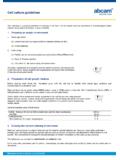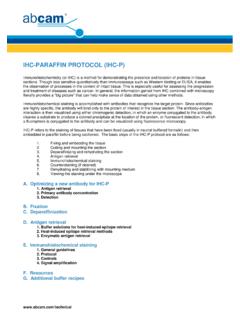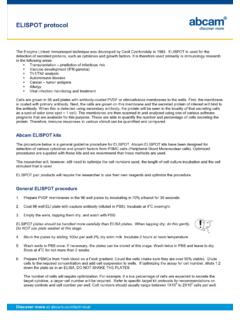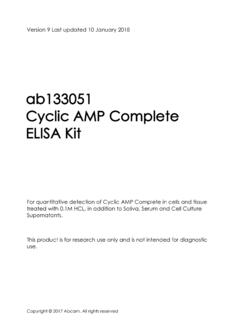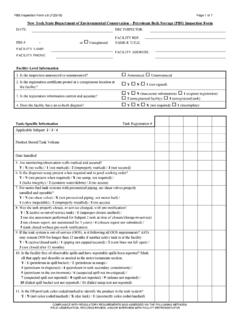Transcription of General protocols for inducing apoptosis in cells - …
1 Discover more at General protocols for inducing apoptosis in cells apoptosis may be induced in experimental systems through a variety of methods. In General , they can be divided into 2 categories: a) biological induction; and b) chemical induction. A) Biological induction of apoptosis 1. Activation of either Fas or TNF-receptors by the respective ligands or by crosslinking with agonist antibody induces apoptosis of Fas- or TNF receptor-bearing cells . Below is General protocol used to induce apoptosis using anti-Fas mAb in Jurkat cells . 2. Grow Jurkat cells in RPMI-1640 medium containing 10% fetal bovine serum in a humidified, 5% CO2 incubator at 37 C. 3. Suspend the cells in fresh medium at a concentration of 1 105 cells /ml.
2 After two to three days of incubation in a 37 C, 5% CO2 incubator, harvest the cells by centrifugation at 300 350 g for 5 mins. 4. Resuspend cells in fresh medium to 5 105 cells /ml and add anti-Fas mAb to a final concentration of g/ml. 5. Incubate for 3 6 hours in a 37 C incubator. As a negative control, incubate untreated cells (no anti-Fas mAb) under the same conditions. (Stop here for homogeneous assay, or plate the cells in a 96-well plate.) 6. Harvest the cells by centrifugation at 300 350 g for 5 mins. 7. Remove all medium and resuspend cells in PBS. 8. Repeat centrifugation and resuspend the cell pellet in PBS to 106 cells /ml. 9. Proceed to apoptosis detection.
3 B) Chemical induction of apoptosis Depending on the agent selected and the concentrations used, maximal induction of a particular protein may occur within 8 to 72 hours post-treatment. However, not all proteins are affected by reagents in a particular cell line. The following protocol is based on p53-dependent G1-arrest that occurs in response to DNA damage by chemical agents. A typical time course for p53 induction is 40 to 48 hours treatment with a DNA damaging agent. 1. Inoculate each of 2 or more 10 cm2 tissue culture dishes for adherent cells or T-75 flasks for non-adherent cells with approximately 1 x 106 cells . One dish or flask will be used as negative control for non-induced or basal level expression.
4 2. Confirm that cells are growing by visual inspection of tissue culture dishes or by viable cell counts on non-adherent cells in T-75 flasks. Add DNA damaging agents to recommended final concentrations. The list below gives suggestions of final concentrations that can be used for several well known apoptosis inducing chemicals: Examples: g/ml Doxorubicin (stock prepared in H2O, 25 g/ml) 5-Fluorouracil (stock prepared in DMSO) 100-58 nM Paclitaxel (stock prepared in DMSO) 60 nM Vinblastine (stock prepared in methanol) 1 mM staurosporine in DMSO Add appropriate volume of buffer or solvent ( DMSO) to the non-induced control. 3.
5 Check cells to determine if cells have begun to apoptose. This can be assessed by checking the morphology of the cells ( cells will become granulated and blebbing may be observed). Viability can be checked using trypan blue cell counting. Harvest cells if greater than 75% of the cells appear to have died upon trypan blue viability counting. Discover more at 4. Harvest cells and prepare lysates for either western blotting or immunoprecipitation. For any agent used, a time course of induction can be performed by inoculating additional dishes or flasks and harvesting at various times ( 24, 48 and 72 hours) after addition of the DNA damaging agent. For the examination of apoptotic proteins, dead cells should also be collected.
6 Always compare levels of p53 from treated cells and controls to confirm induction.
